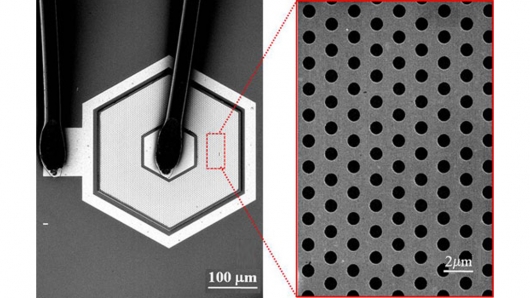
© GizmagThe new 'microlens' (left) leverages the unique properties of nanoscale gold to 'squeeze' light into the tiny holes in its surface (magnified on the right).
Anyone who likes to get their gear off for a spot of naked sunbathing in the backyard may have to think twice in the future. Researchers have developed a new nanotechnology-based "microlens" that could lead to a new generation of ultra-powerful satellite cameras and night-vision devices. Thankfully, the new lens is used for infrared imaging, so the technology is more likely to be used for security and monitoring climate change and deforestation than spying on naturists boosting their vitamin D levels.
Developed by researchers at
Rensselaer Polytechnic Institute, the lens uses gold to boost the strength of infrared imaging. By leveraging the unique properties of nanoscale gold to "squeeze" light into tiny holes in the surface of the device, the researchers have doubled the detection cabability of a quantum dot-based infrared detector. With some refinements, the researchers expect this new technology should be able to enhance this by up to 20 times.
According to project leader Shawn-Yu Lin, professor of physics at Rensselaer, the breakthrough is the first in more than a decade to demonstrate success in enhancing the signal of an infrared detector without also increasing the noise.
"Infrared detection is a big priority right now, as more effective infrared satellite imaging technology holds the potential to benefit everything from homeland security to monitoring climate change and deforestation," said Lin.

